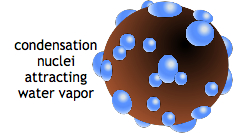
|

|


What happens inside a cloud?
Micro-scale Processes - Cloud Droplet Formation
Hygroscopic particles (for example, salt) have an affinity for water and allow water to condense when the relative humidity is lower than 100%. Once a hygroscopic particle serves as a condensation nucleus, it can dissolve and form a solute. The solute will have a lower saturation vapor pressure than pure water, which makes it easier for the droplet to grow in unsaturated air.
 Once a droplet is formed, it does not just sit there. Condensation and
evaporation are both constantly taking place at the droplet's surface. If there
is more condensation, the droplet grows; if there is more evaporation, the
droplet shrinks. If both processes occur at an equal rate, the droplet stays the
same size.
Once a droplet is formed, it does not just sit there. Condensation and
evaporation are both constantly taking place at the droplet's surface. If there
is more condensation, the droplet grows; if there is more evaporation, the
droplet shrinks. If both processes occur at an equal rate, the droplet stays the
same size.
A side effect of condensing water vapor is latent heat latent heat release. The extra heat can fuel the buoyancy in the cloud and extend the cloud's life. Conversely, evaporation takes heat from the air and so this deters cloud growth.
Next page -> Micro-scale processes - rain droplet formation
Links and resources
Micro-scale Processes - Cloud Droplet Formation
Hygroscopic particles (for example, salt) have an affinity for water and allow water to condense when the relative humidity is lower than 100%. Once a hygroscopic particle serves as a condensation nucleus, it can dissolve and form a solute. The solute will have a lower saturation vapor pressure than pure water, which makes it easier for the droplet to grow in unsaturated air.
 Once a droplet is formed, it does not just sit there. Condensation and
evaporation are both constantly taking place at the droplet's surface. If there
is more condensation, the droplet grows; if there is more evaporation, the
droplet shrinks. If both processes occur at an equal rate, the droplet stays the
same size.
Once a droplet is formed, it does not just sit there. Condensation and
evaporation are both constantly taking place at the droplet's surface. If there
is more condensation, the droplet grows; if there is more evaporation, the
droplet shrinks. If both processes occur at an equal rate, the droplet stays the
same size.A side effect of condensing water vapor is latent heat latent heat release. The extra heat can fuel the buoyancy in the cloud and extend the cloud's life. Conversely, evaporation takes heat from the air and so this deters cloud growth.
Next page -> Micro-scale processes - rain droplet formation
Links and resources
